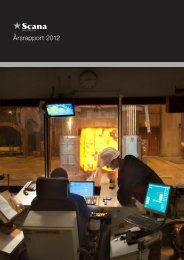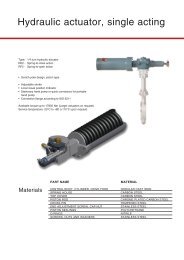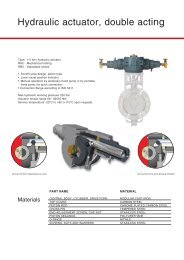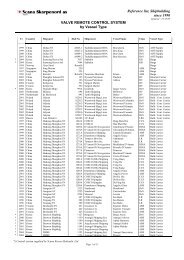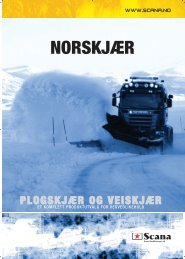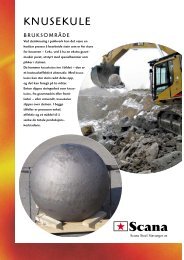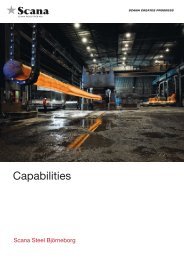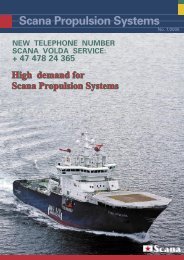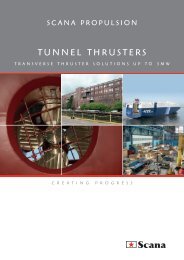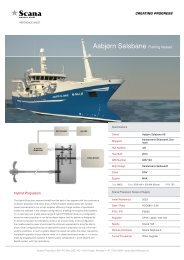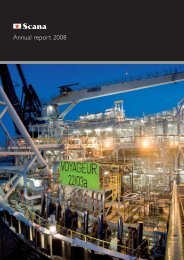Annual Report 2010 - Scana Industrier ASA
Annual Report 2010 - Scana Industrier ASA
Annual Report 2010 - Scana Industrier ASA
Create successful ePaper yourself
Turn your PDF publications into a flip-book with our unique Google optimized e-Paper software.
55Where the group expects some or all of a provision to be reimbursed,for example under an insurance contract, the reimbursement isrecognised as a separate asset but only when the reimbursement isvirtually certain. The expense relating to any provision is presentedin the profit and loss account net of any reimbursement. If the effectof the time value of money is material, provisions are discountedusing a current pre-tax rate that reflect the risks that are specific tothe relevant liability. Where discounting is used, the increase in theprovision due to the passage of time is recognised as a financialexpense.of a fall in value, the book value is evaluated against the recoverableamount.Deferred tax assetThe deferred tax asset is recognised when it is probable that therewill be future taxable income and that the temporary differencesor loss carry-forward can be deducted in this income. Changes inassumptions and estimates can make it necessary to reduce thedeferred tax asset. The company has carried out a test related to therecognised deferred tax asset.<strong>Annual</strong> <strong>Report</strong> <strong>2010</strong> <strong>Scana</strong> <strong>Industrier</strong> <strong>ASA</strong>A guarantee provision is recognised when the underlying productsare sold. The provision is based on historical information aboutguarantees and a weighting of possible outcomes against theirprobability of occurring.Derecognition of financial assets and liabilitiesA financial asset (or where applicable a part of a financial assetor part of a group of similar financial assets) is deducted from thebalance sheet where:• the rights to receive cash flows from the asset have expired,• the group retains the right to receive cash flows from the asset,but has assumed an obligation to pay them in full without materialdelay to a third party under a ‘pass-through’ arrangement, or• the group has transferred its rights to receive cash flows from theasset and either (a) has transferred almost all risks and potentialgains associated with the asset, or (b) has neither transferred norretained the majority of risks and potential gains associated withthe asset, but has transferred control of the asset.A financial liability is derecognised when the obligation is settled,cancelled or expires. Where an existing financial liability is replacedby another from the same lender on substantially different terms, orthe terms of an existing liability are substantially modified, such anexchange or modification is treated in such a way that the originalliability is removed from the balance sheet and a new liability isrecorded in the balance sheet. The difference in the respective bookamounts is entered in the profit and loss account.Note 2. Estimate uncertaintyEstimates and judgements are evaluated on an ongoing basis andare based on historical experience and other factors, includingforecasts of future events that are regarded as being probable underthe present circumstances.The group draws up estimates and makes assumptions/forecastslinked to the future. The accounting estimates that result from this willper definition rarely be completely in agreement with the final result.Estimates and assumptions/forecasts with a considerable risk ofleading to material adjustments of recognised values, are discussedbelow.Impairment assessmentThe group carries out impairment tests annually on cash generatingunits with goodwill items and units showing indications of a fall invalue. An impairment test is carried out for the cash flow-generatingunits with recognised goodwill items. This is done based on futurecash flows and discount rates. Changes in these assumptions andestimates can lead to a write-down, which is entered in the profit andloss account. Where there are indications of a fall in value, the bookvalue is assessed against the recoverable amount.Development costsThe company activates development costs in accordance with thecriteria for activation in IAS38. The present value of the estimatedcash flow is based on budgets and business plans. Otherdevelopment costs in the group are expected to have a limitedlifetime and the estimates are based on a 5-year horizon. Changesin these assumptions and estimates can lead to a write-down beingentered in the profit and loss account. Where there are indicationsInventoryValued at the lower of the purchase/production cost and expectednet sales value. The net sales value is estimated at the selling priceduring further operations, minus estimated costs of completion,marketing and distribution. Changes in estimates related to theexpected net sales value can lead to changes in product costs.Trade receivablesTrade receivables are assessed on an ongoing basis, and the writedownof the trade receivables is carried out if there are objectivecriteria for the occurrence of a loss-triggering event that can bemeasured reliably and will affect the payment of the receivable.Changes in management’s basis for the assessment of the credit riskmay affect the estimated loss provision. In the same way, changesin market conditions, internal conditions at our customers, etc. canmean a final result that deviates from the write-down of the tradereceivables.Manufacturing contractsWhen reporting manufacturing contracts, assumptions are maderegarding estimated costs and earnings as well as the definition andmeasurement of degree of completion. Changes in these estimatesmay mean that reporting of revenue and earnings deviates from theunderlying value created, relative to the project’s overall revenue andearnings. Thus, earnings can be reported too early or too late in theproject.Guarantee provisionsThe management estimate the provision for future guaranteeobligations based on information on historical guaranteerequirements, together with other information to calculate futureguarantee obligations. Factors that can affect estimated obligationsinclude unknown errors in completed deliveries. For furtherinformation, see note 18.Note 3. Segment informationBUSINESS AREAS<strong>Scana</strong> is a Nordic industrial group operating in three business areas:Steel, Marine and Oil & Gas. The main products for the steel businessarea are customised steel forgings and castings for the oil and gas,energy, marine, machine and tool industries. For the marine businessarea, the products include gears, propellers, propulsion systems,hydraulic actuators and valve control systems. The companies in theoil and gas business area provide design and production, in additionto the maintenance and repair of equipment and steel componentsfor the oil and gas industries. The presentation coincides with theinternal reporting to the Board.Internal costs in the parent company that are not owner costsare divided between the business areas and their subsidiaries.Revenues from sales to external customers and transactions withother segments are reported in each of the business areas. Internaldeliveries are booked at estimated market value. Sales between thebusiness areas only occur to a limited extent. “Eliminations” primarilyrefer to eliminations within business areas. Other mainly refers torevenues/costs relating to group management and its associatedstaff and administration. Assets and liabilities included in “other”mainly apply to the parent company. Investments in associatedcompanies are broken down into the different business areas.



